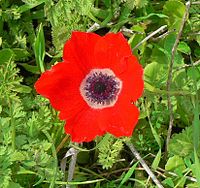Cropping (image)
This article needs additional citations for verification. (October 2008) |
Cropping is the removal of unwanted outer areas from a photographic or illustrated image. The process often consists the removal of the outer parts or background of an image to improve framing or change aspect ratio to accentuate or isolate the subject matter. Depending on the application, this may be performed on a physical photograph, artwork or film footage, or achieved digitally using image editing software. The practice is common to the film, broadcasting, photographic, graphic design, and printing industries.
Cropping in photography, print & design


In the printing, graphic design and photography industries, cropping[1] is the removal of unwanted areas from a photographic or illustrated image. One of the most basic photo manipulation processes, it is performed in order to remove an unwanted subject or irrelevant detail from a photo, change its aspect ratio, or to improve the overall composition.[2] In telephoto photography, most commonly in bird and aviation photography, an image is cropped to magnify the primary subject and further reduce the angle of view when a lens of sufficient focal length to achieve the desired magnification directly is not available. It is considered one of the few editing actions permissible in modern photojournalism along with tonal balance, colour correction and sharpening. A cropping made by removing the top and bottom edges of a photograph or film produces an view that mimics the panoramic format (in photography) or the widescreen format in cinematography and broadcasting. Neither of these formats id cropped as such, but rather they are producta of highly specialised optical configurations and camera designs.
Graphic examples (photography)
Cropping in order to emphasize the subject:
-
Cropped image of Anemone coronaria, aspect ratio 1.065, in which the flower fills most of the frame
-
The original photo, aspect ratio 1.333, in which the flower uses only a small part of the frame
Cropping in order to remove unwanted details/objects:
-
Cropped image of Garland chrysanthemum, aspect ratio 16:4
-
The original photo, aspect ratio 1.333, the lower right part shows some white-colored trash and the upper right shows dead flower - both are unwanted objects.
Cropping in cinematography & broadcasting
In certain circumstances, film footage may be cropped to change it from one aspect ratio to another, without stretching the image or filling the blank spaces with letterbox bars (fig. 2).
Concerns about aspect ratios are a major issue in filmmaking. Rather than cropping, the cinematographer traditionally uses mattes to increase the latitude for alternative aspect ratios in projection and broadcast. Anamorphic optics (such as Panavision lenses) produce a full-frame, horizontally compressed image from which broadcasters and projectionists can matte a number of alternative aspect ratios without cropping relevant image detail. Without this, widescreen reproduction, especially for television broadcasting, is dependent upon a variety of soft matting techniques such as letterboxing, which involves varying degrees of image cropping [1](see figures 2, 3 and 4)
Since the advent of widescreen television, a similar process removes large chunks from the top & bottom to make a standard 4:3 image fit a 16:9 one, losing 25% of the original image. This process has become standard in the United Kingdom,[citation needed] fot television programs in which many archive clips are used. This gives them a zoomed-in, cramped image with significantly reduced . Another option is a process called pillarboxing, where black bands are placed down the sides of the screen, allowing the original image to be shown full-frame within the wider aspect ratio (fig. 6). See this article for a fuller description of the problem.
- Typical cropping in cinematographic and broadcast applications
-
Figure 1:
2.35:1 original image with widescreen aspect ratio, showing alternative aspect ratios -
Figure 2:
2.35:1 image with letterbox resized to 4:3, the whole image is visible -
Figure 3:
1.85:1 image with letterbox resized to 4:3. Typical 16:9 image, the outer edges of the image are not visible -
Figure 4:
1.55:1 image with letterbox resized to 4:3. A compromise between 16:9 and 4:3, often broadcast in the UK -
Figure 5:
1.33:1 image without letterbox, because it is cropped to 4:3, losing much of the original
Additional methods
Various methods may be used following cropping or may be used on the original image.
- Vignetting is the accentuation of the central portion of an image by blurring, darkening, lightening, or desaturation of peripheral portions of the image
- The use of non-rectangular mat or picture frame may be used for selection of portions of a larger image
Uncropping
It is not possible to "uncrop" a cropped image unless the original still exists or undo information exists: if an image is cropped and saved (without undo information), it cannot be recovered without the original.
However, using texture synthesis, it is possible to artificially add a band around an image, synthetically "uncropping" it. This is effective if the band smoothly blends with the existing image, which is relatively easy if the edge of the image has low detail or is a chaotic natural pattern such as sky or grass, but does not work if discernible objects are cut off at the boundary, such as half a car. An uncrop plug-in exists for the GIMP image editor.
References
- ^ "Crop Images With PHP and Jquery". Archived from the original on 2011-12-13.
{{cite web}}: Unknown parameter|deadurl=ignored (|url-status=suggested) (help) - ^ "Automatic image cropping to improve composition".









